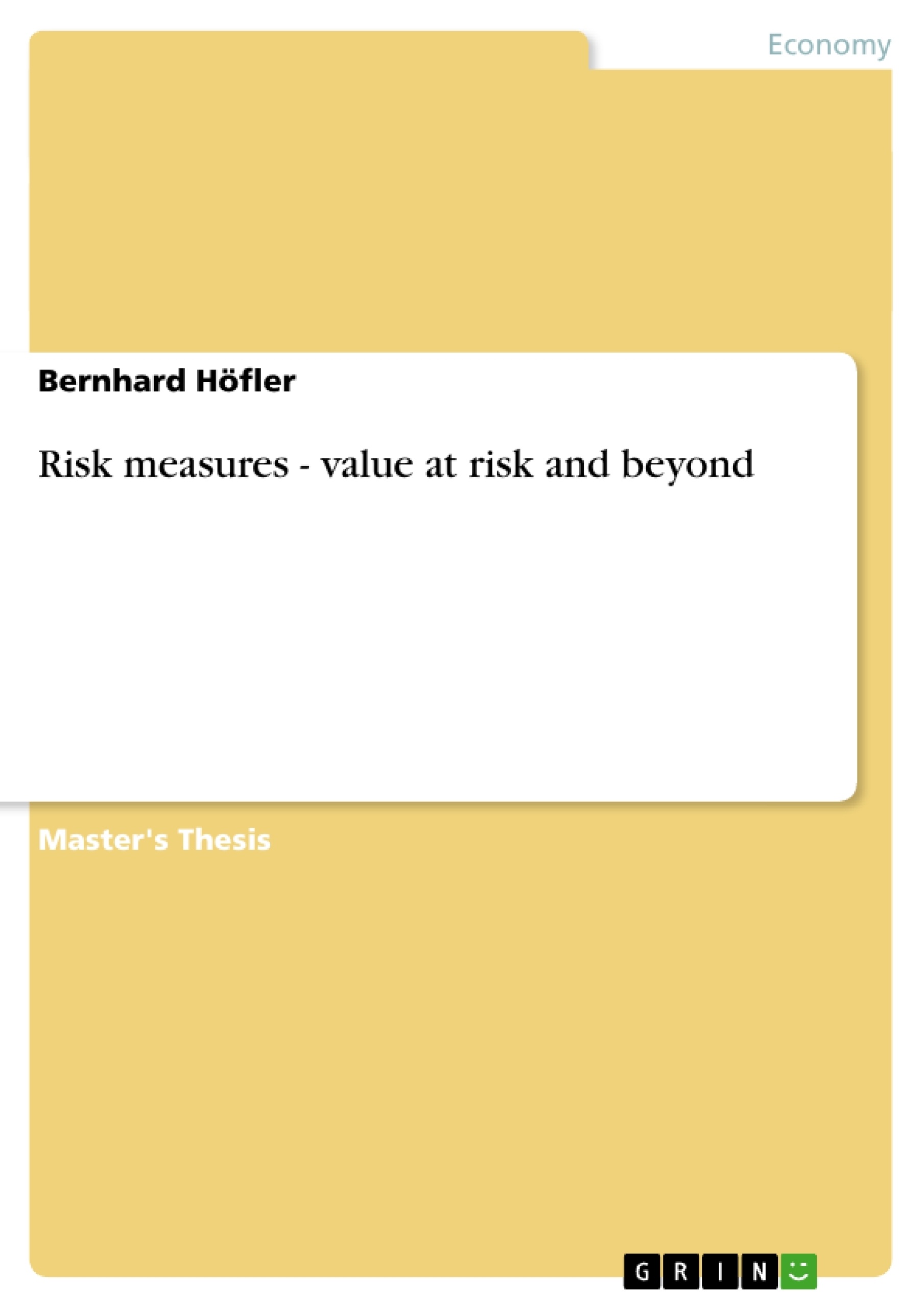This thesis provides an exhaustive and well-founded overview of risk measures, in particular of Value at Risk (VaR) and risk measures beyond VaR.
Corporations are exposed to different kinds of risks and therefore risk management has become a central task for a successful company. VaR is nowadays widely adapted internationally to measure market risk and is the most frequently used risk measure amongst practitioners due to the fact that the concept offers several advantages. However, VaR also has its drawbacks and hence there have been and still are endeavours to improve VaR and to find better risk measures.
In seeking alternative risk measures to try to overcome VaR’s disadvantages, while still keeping its advantages, risk measures beyond VaR were introduced. The most important alternative risk measures such as Tail Conditional Expectation, Worst Conditional Expectation, Expected Shortfall, Conditional VaR, and Expected Tail Loss are presented in detail in the thesis. It has been found that the listed risk measures are very similar concepts of overcoming the deficiencies of VaR and that there is no clear distinction between them in the literature – ‘confusion of tongues’ would be an appropriate expression. Two concepts have become widespread in the literature in recent years: Conditional VaR and Expected Shortfall, however there are situations where it can be seen that these are simply different terms for the same measure.
Additionally other concepts are touched upon (Conditional Drawdown at Risk, Expected Regret, Spectral Risk Measures, Distortion Risk Measures, and other risk measures) and modifications of VaR (Conditional Autoregressive VaR, Modified VaR, Stable modelling of VaR) are introduced.
Recapitulatory the basic findings of the thesis are that there are numerous sophisticated alternative measures and concepts readily available, that there prevails a ‘confusion of tongues’ with the alternative risk measures in the respective literature and that promising theories and models are on the verge of entering the mainstream financial risk management stage. At the end of the day however neither VaR nor any other introduced risk measure is perfect. There are certain limitations aligned with every method; no single method is the best risk measure.
Inhaltsverzeichnis (Table of Contents)
- PREFACE
- ABSTRACT
- ABBREVIATIONS
- TABLES
- FIGURES
- 1 INTRODUCTION
- 2 INTRODUCTION TO RISK
- 2.1 DEFINITION OF “RISK”
- 2.2 TYPES OF RISK
- 2.3 MARKET RISK
- 2.4 MEASURING RISK
- 3 VALUE AT RISK (VAR)
- 3.1 HISTORY OF VAR, RISKMETRICS
- 3.2 WHAT IS VAR?
- 3.3 COMPUTING VAR
- 3.3.1 Analytic, Variance-Covariance or Parametric Approach
- 3.3.2 Historical Simulation Approach
- 3.3.3 Monte Carlo Simulation Approach
- 3.3.4 Choosing between methods
- 4 CRITICISM ON VALUE AT RISK
- 4.1 CONCEPT OF COHERENT RISK MEASURES
- 4.2 ADVANTAGES OF VAR
- 4.3 DRAWBACKS AND FLAWS OF VAR
- 4.3.1 VaR and Subadditivity
- 4.3.2 Further weaknesses of VaR
- 4.3.3 The Jorion-Taleb Debate
- 5 BEYOND VALUE AT RISK
- 5.1 TAIL CONDITIONAL EXPECTATION (TCE)
- 5.2 WORST CONDITIONAL EXPECTATION (WCE)
- 5.3 EXPECTED SHORTFALL (ES)
- 5.4 CONDITIONAL VALUE AT RISK (CVAR)
- 5.5 EXPECTED TAIL LOSS (ETL)
- 5.6 CONFUSION OF TONGUES
- 5.7 CONDITIONAL DRAWDOWN (CDD) AT RISK (CDAR)
- 5.8 EXPECTED REGRET (ER)
- 5.9 SPECTRAL RISK MEASURES
- 5.10 DISTORTION RISK MEASURES
- 5.11 OTHER RISK MEASURES
- 5.12 MODIFICATIONS OF VALUE AT RISK
- 5.12.1 Conditional Autoregressive Value at Risk (CAViaR)
- 5.12.2 Modified VaR
- 5.12.3 Stable modelling of VaR
- 5.13 OUTLOOK ON RESEARCH IN RISK MEASUREMENT
Zielsetzung und Themenschwerpunkte (Objectives and Key Themes)
This master's thesis explores risk measures, focusing primarily on Value at Risk (VaR) and its limitations. The work aims to critically evaluate the effectiveness of VaR as a risk measure and investigate alternative approaches to risk assessment. The thesis examines how VaR is used in practice, analyzes its strengths and weaknesses, and explores the theoretical foundations of alternative risk measures.
- Value at Risk (VaR) and its role in risk management
- Criticisms and limitations of VaR
- Alternative risk measures beyond VaR
- The theoretical foundations of risk measures
- The practical application of risk measures
Zusammenfassung der Kapitel (Chapter Summaries)
- Chapter 1: Introduction: Introduces the topic of risk measurement and provides a brief overview of the thesis's scope and structure.
- Chapter 2: Introduction to Risk: Discusses the concept of risk, defines different types of risk, particularly focusing on market risk, and explores the importance of risk measurement.
- Chapter 3: Value at Risk (VaR): Explores the historical development of VaR, explains what VaR is, and outlines various methods for calculating it, including analytic, historical simulation, and Monte Carlo simulation approaches.
- Chapter 4: Criticism on Value at Risk: Analyzes the strengths and weaknesses of VaR. It introduces the concept of coherent risk measures and explores specific limitations of VaR, including subadditivity and the Jorion-Taleb debate.
- Chapter 5: Beyond Value at Risk: Presents alternative risk measures to address the limitations of VaR. This includes examining Tail Conditional Expectation, Worst Conditional Expectation, Expected Shortfall, Conditional Value at Risk, Expected Tail Loss, and various modifications of VaR.
Schlüsselwörter (Keywords)
The thesis focuses on risk measures, particularly Value at Risk (VaR), alternative risk measures, coherent risk measures, market risk, risk management, financial risk, and the theoretical foundations of risk assessment.
- Citar trabajo
- MMag. Bernhard Höfler (Autor), 2007, Risk measures - value at risk and beyond, Múnich, GRIN Verlag, https://www.grin.com/document/83867



